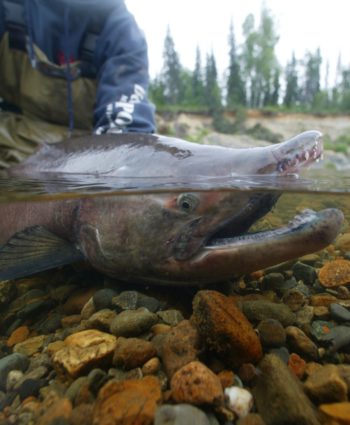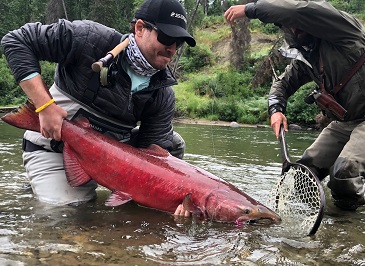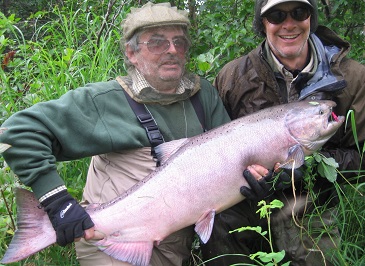Page - King Salmon Fishing
ALASKA KING SALMON FISHING
King Salmon, often known as Chinook Salmon, start to arrive on the Talachulitna and in our neighboring tributaries at the end of June through early July. Similar to the other salmon species, once they enter fresh water they’re on a spawning run and thus stop feeding. So “matching the hatch” does not apply to these species. Rather, in order to catch them bright colored streamers or spinners are used to evoke a response, such as territorial aggression, or a habitual biting reaction.
Unlike the other salmon species that have fairly consistent lifecycles, King Salmon can range in age. As juveniles they spend two years in the Tal before becoming silver smolt, at which point they start to migrate toward salt water. A king that comes back after only one year in the ocean is known as a “Jack” and can range between 12-16 inches and 2-3 pounds.
Kings that stay in the ocean for 2-3 years can be around 7-10 pounds when entering the Tal, whereas kings that stay upwards of 5 years come back weighing 30-40 pounds. These “monster” kings are common to the Talachulitna and its surrounding tributaries.
Over the years there has been a decline in king salmon spawning runs throughout the Pacific Northwest and Alaska territories, thus Fish and Game has started to regulate their season. Be sure to check in with us for the latest Fish and Game requirements should you be interested in this specific species.
If you’re a skilled fly caster, fly fishing for kings can be very effective and fun – they’re an aggressive species and when they bite, they bite! The Tal has perfect conditions for this species: a combination of runs and pools. Often times kings can be spotted holding in the current and it’s very exciting to see what you’re fishing for. We suggest 12 to 14 foot double handed rods and skagit lines to swing big marabou or intruder-style flies.
If you’re a spin caster we tend to steer you away from this particular salmon species, since often times when they bite a lure it’s deep and renders them dead. Allowing this species to carry on and do what they’ve come to do – spawn and recreate – is one of our top priorities and one of the main reasons we still see so many “monster” kings in our waters.

WE CALL THEM KING FOR A REASON



